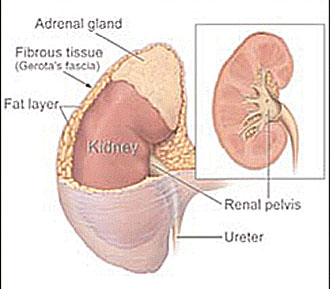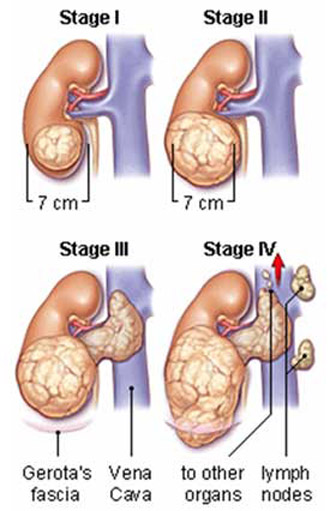kidney cancer

The kidneys are a pair of organs on either side of the spine in the lower abdomen. Each kidney is about the size of a fist. Attached to the top of each kidney is an adrenal gland. A mass of fatty tissue and an outer layer of fibrous tissue (Gerota's fascia) enclose the kidneys and adrenal glands. The kidneys are part of the urinary system. They make urine by removing wastes and extra water from the blood. Urine collects in a hollow space (renal pelvis) in the middle of each kidney. It passes from the renal pelvis into the bladder through a tube called a ureter. Urine leaves the body through another tube (the urethra). The kidneys also make substances that help control blood pressure and the production of red blood cells.

Stages of renal cell carcinoma. Stage I: Cancer is in the kidney only and the size of the tumor is less than or equal to 7 cm in diameter. Stage II: Cancer is in the kidney only but the size of the tumor is greater than 7 cm in diameter. Stage III: The tumor in the kidney may be any size, but it extends beyond the layer of tissue (Gerota's fascia) that encapsulates the kidney and adrenal gland. Additionally, cancer may have spread to blood vessels that carry blood away from the kidney, or to the adjacent adrenal gland. Stage IV: Tumor in the kidney extends beyond Gerota's fascia and/or cancer has spread to one or more lymph node near the kidney. In addition, there may be evidence that cancer has spread to other organs in the body, such as the lungs, liver, brain, or bones. Source: Kidney Science Program, Oregon Health & Science University
Kidney cancer is any of several types of cancer can start in the kidney. The most common type of kidney cancer in adults is renal cell cancer, which is also called renal adenocarcinoma or hypernephroma. Another type of cancer, transitional cell carcinoma, affects the renal pelvis. It is similar to bladder cancer and is often treated like bladder cancer. Wilms' tumor is the most common type of childhood kidney cancer. It is different from adult kidney cancer and requires different treatment.
What follows applies specifically to renal cell cancer.
Risk factors
Kidney cancer develops most often in people over 40, but no one knows the exact causes of this disease. Doctors can seldom explain why one person develops kidney cancer and another does not. However, it is clear that kidney cancer is not contagious. No one can "catch" the disease from another person.
Research has shown that people with certain risk factors are more likely than others to develop kidney cancer. A risk factor is anything that increases a person's chance of developing a disease.
Studies have found the following risk factors for kidney cancer:
Most people who have these risk factors do not get kidney cancer. On the other hand, most people who do get the disease have no known risk factors.
Symptoms
Common symptoms of kidney cancer include:
Most often, these symptoms do not mean cancer. An infection, a cyst, or another problem also can cause the same symptoms. A person with any of these symptoms should see a doctor so that any problem can be diagnosed and treated as early as possible.
Diagnosis
If a patient has symptoms that suggest kidney cancer, the doctor may perform one or more of the following procedures:
Staging
To plan the best treatment, the doctor needs to know the stage (extent) of the disease. The stage is based on the size of the tumor, whether the cancer has spread and, if so, to what parts of the body (see illustration above).
Staging may involve imaging tests such as an ultrasound or a CT scan. The doctor also may use an MRI. For this test, a powerful magnet linked to a computer makes detailed pictures of organs and blood vessels.
Doctors describe kidney cancer by the following stages:
- The tumor does not extend beyond the kidney, but cancer cells have spread through the lymphatic system to one nearby lymph node; or
- The tumor has invaded the adrenal gland or the layers of fat and fibrous tissue that surround the kidney, but cancer cells have not spread beyond the fibrous tissue. Cancer cells may be found in one nearby lymph node; or
- The cancer cells have spread from the kidney to a nearby large blood vessel. Cancer cells may be found in one nearby lymph node.
- The tumor extends beyond the fibrous tissue that surrounds the kidney; or
- Cancer cells are found in more than one nearby lymph node; or
- The cancer has spread to other places in the body such as the lungs.
Treatment
Treatment depends mainly on the stage of disease and the patient's general health and age. People with kidney cancer may have surgery, arterial embolization, radiation therapy, biological therapy, or chemotherapy. Some may have a combination of treatments.
At any stage of disease, people with kidney cancer may have treatment to control pain and other symptoms, to relieve the side effects of therapy, and to ease emotional and practical problems. This kind of treatment is called supportive care, symptom management, or palliative care.
Because treatment may damage healthy cells and tissues, unwanted side effects are common. These side effects depend mainly on the type and extent of the treatment. Side effects may not be the same for each person, and they may change from one treatment session to the next. Before treatment starts, the health care team will explain possible side effects and suggest ways to help the patient manage them.
Surgery
Surgery is the most common treatment for kidney cancer. It is a type of local therapy. It treats cancer in the kidney and the area close to the tumor.
An operation to remove the kidney is called a nephrectomy. There are several types of nephrectomies. The type depends mainly on the stage of the tumor. The doctor can explain each operation and discuss which is most suitable for the patient:
It takes time to heal after surgery, and the time needed to recover is different for each person. Patients are often uncomfortable during the first few days. However, medicine can usually control their pain. Before surgery, patients should discuss the plan for pain relief with the doctor or nurse. After surgery, the doctor can adjust the plan if more pain relief is needed.
It is common to feel tired or weak for a while. The health care team watches the patient for signs of kidney problems by monitoring the amount of fluid the patient takes in and the amount of urine produced. They also watch for signs of bleeding, infection, or other problems requiring immediate treatment. Lab tests help the health care team monitor for signs of problems.
If one kidney is removed, the remaining kidney generally is able to perform the work of both kidneys. However, if the remaining kidney is not working well or if both kidneys are removed, dialysis is needed to clean the blood. For a few patients, kidney transplantation may be an option. For this procedure, the transplant surgeon replaces the patient's kidney with a healthy kidney from a donor.
Arterial embolization
Arterial embolization is a type of local therapy that shrinks the tumor. Sometimes it is done before an operation to make surgery easier. When surgery is not possible, embolization may be used to help relieve the symptoms of kidney cancer.
The doctor inserts a narrow tube (catheter) into a blood vessel in the leg. The tube is passed up to the main blood vessel (renal artery) that supplies blood to the kidney. The doctor injects a substance into the blood vessel to block the flow of blood into the kidney. The blockage prevents the tumor from getting oxygen and other substances it needs to grow.
After arterial embolization, some patients have back pain or develop a fever. Other side effects are nausea and vomiting. These problems soon go away.
Radiation therapy
Radiation therapy (also called radiotherapy) is another type of local therapy. It uses high-energy rays to kill cancer cells. It affects cancer cells only in the treated area. A large machine directs radiation at the body. The patient has treatment at the hospital or clinic, 5 days a week for several weeks.
A small number of patients have radiation therapy before surgery to shrink the tumor. Some have it after surgery to kill cancer cells that may remain in the area. People who cannot have surgery may have radiation therapy to relieve pain and other problems caused by the cancer.
The side effects of radiation therapy depend mainly on the amount of radiation given and the part of the body that is treated. Patients are likely to become very tired during radiation therapy, especially in the later weeks of treatment. Resting is important, but doctors usually advise patients to try to stay as active as they can.
Radiation therapy to the kidney and nearby areas may cause nausea, vomiting, diarrhea, or urinary discomfort. Radiation therapy also may cause a decrease in the number of healthy white blood cells, which help protect the body against infection. In addition, the skin in the treated area may sometimes become red, dry, and tender. Although the side effects of radiation therapy can be distressing, the doctor can usually treat or control them.
Biological therapy
Biological therapy is a type of systemic therapy. It uses substances that travel through the bloodstream, reaching and affecting cells all over the body. Biological therapy uses the body's natural ability (immune system) to fight cancer.
For patients with metastatic kidney cancer, the doctor may suggest interferon alpha or interleukin-2 (also called IL-2 or aldesleukin). The body normally produces these substances in small amounts in response to infections and other diseases. For cancer treatment, they are made in the laboratory in large amounts.
Biological therapy may cause flu-like symptoms, such as chills, fever, muscle aches, weakness, loss of appetite, nausea, vomiting, and diarrhea. Patients also may get a skin rash. These problems can be severe, but they go away after treatment stops.
Chemotherapy
Chemotherapy is also a type of systemic therapy. Anticancer drugs enter the bloodstream and travel throughout the body. Although useful for many other cancers, anticancer drugs have shown limited use against kidney cancer. However, many doctors are studying new drugs and new combinations that may prove more helpful.
The side effects of chemotherapy depend mainly on the specific drugs and the amount received at one time. In general, anticancer drugs affect cells that divide rapidly, especially:
Follow-up care
Follow-up care after treatment for kidney cancer is important. Even when the cancer seems to have been completely removed or destroyed, the disease sometimes returns because cancer cells can remain in the body after treatment. The doctor monitors the recovery of the person treated for kidney cancer and checks for recurrence of cancer. Checkups help ensure that any changes in health are noted. The patient may have lab tests, chest X-rays, CT scans, or other tests.


